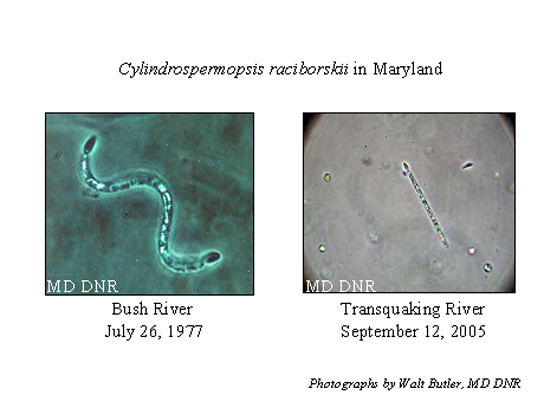|
|
|
A diverse community of cyanobacteria, commonly known as blue-green algae, has been persisting in blooms for over a month on the upper Transquaking (Dorchester County) and Sassafras (Kent and Cecil Counties) Rivers (see the HAB News story from September 7,2005: "Caution to River Users: Blue-green algae (Cyanobacteria) abundant in localized blooms on the upper Sassafras River and upper Transquaking River." for more details). Among the notable species recognized by Walt Butler at Maryland Department of Natural Resources (DNR) was Cylindrospermopsis raciborskii at a density of 53 cells per milliliter at Marylands long-term water quality monitoring station on the Sassafras River collected September 14, and 13,250 cells per milliliter at the Decoursey Road Bridge site on the Transquaking River collected September 12. Identification of C. raciborskii was confirmed by the laboratory of Dr. Wayne Carmichael at Wright State University. Marylands first record of this species dates back to the Bush River, July 26, 1977, recently reconfirmed from a photograph (Figure 1). Curly and straight strain varieties exist and are evident between the two photographs. Worldwide this is becoming an important species of concern due to its increased detection, expanding distribution, preference for nutrient-enriched waters and a varied ability to produce toxins (different strains may or may not produce toxins) that have been known to harm insects, fish, pets, livestock and humans.
In recent years, this species has begun replacing other bloom-forming algae as the dominant alga following the nutrient enrichment of lakes, reservoirs, and rivers around the world. This particular species is said to grow abundantly in subtropical freshwater lakes and rivers with high levels of phosphorus and other nutrients and appears to grow well at temperatures of 20-35 degrees C (68-95 degrees F). It has been found in India, Zimbabwe, Hungary, Thailand, Mexico, Australia, and Brazil. In the United States, the earliest records may be from Kansas in the 1950s, Minnesota lakes and Lake Erie in the 1960s and 70s. In the 1990s, it appeared widespread in such states as Florida. With improvements in monitoring programs, availability of increasingly nutrient-enriched aquatic habitats favored by this species, and a highly adaptable organism, a survey of literature and websites indicates Cylindrospermopsis raciborskii has now been identified throughout much of the United States. Citizens should take common precautions to reduce the risk of illness or discomfort related to blue-green algal blooms.
|

